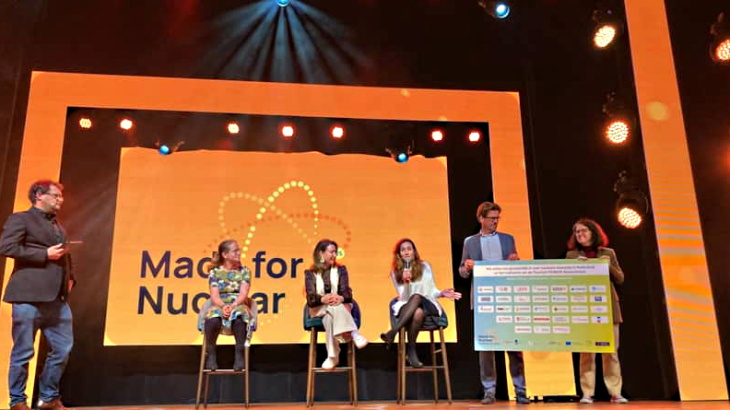While a centralized radioactive water treatment facility starts to make headway in cleaning up highly contaminated water, work to install defences to prevent the contamination of the sea has been completed at the Fukushima Daiichi nuclear power plant.
_1.jpg) |
| Installing concrete plates into seawater intakes at Fukushima (Image: Tepco) |
The tsunami that struck Fukushima Daiichi on 11 March and subsequent water injection measures taken to keep the plant in a stable state have left a legacy of large volumes of highly radioactive contaminated water to deal with. As of 5 July, the four units at the plant held nearly 98,000 tonnes of accumulated contaminated water in the reactor and turbine buildings, while a total accumulated volume of 21,850 tonnes was in storage facilities.
Japan's Nuclear and Industrial Safety Agency (NISA) approved in early June the startup of a centralized radioactive waste treatment facility (CRWTF) capable of processing up to 12,000 tonnes per day. Plant operator Tepco is required to inform NISA of progress in the storage and treatment of water on a weekly basis until all the accumulated water has been transferred to storage facilities and treated.
In the week of 29 June, the CRWTF treated 6380 cubic tonnes contaminated water, bringing the cumulative treated volume to date to 13,610 tonnes. This means that the plant is currently running at about 76% of available capacity, wchich compares well to availability targets of 80% for July and 90% thereafter. At full capacity, the plant should produce 720 tonne of concentrated salt water per day and up to 480 tonnes of fresh water per day.
Water is being injected into units 1 and 2 at rates of around 84 tonnes per day, and into unit 3 at 216 tonnes per day. Since 2 July, treated water has been reinjected back into the system to provide cooling for the stricken reactors.
If the treatment plant continues to work as predicted, Tepco forecasts that by 12 July a further 6720 tonnes will have been treated, bringing the cumulative volume treated to 20,330 tonnes, by which time the total accumulated volume in the reactor and turbine buildings is estimated to be 96,480 tonnes. This represents a reduction in total volumes of only about 2%, but enough to reverse the trend that would have inevitably seen Tepco face a major problem in preventing more water contamination in and around the site.
The concentrated salt water from the operation will be treated in a 250 tonne per day evaporative concentration plant, expected to start operation in August. This will be able to generate up to 83 tonnes of fresh water per day, leaving 167 tonnes of concentrated salt water.
Barriers in place
While the accumulated water inside the reactor buildings is being dealt with, work is also under way to prevent any escape of contaminated water from the plants into the ocean.
A total of 109 concrete plates have been installed in the water intakes for the four units, forming a barrier against any leakage into the sea. The plates measure 1.4 x 4.42 metres, are 32 cm thick and weigh over 4.5 tonnes.
Researched and written
by World Nuclear News




_16403_79272.jpg)


_69218.jpg)

_76087_55556.jpg)



